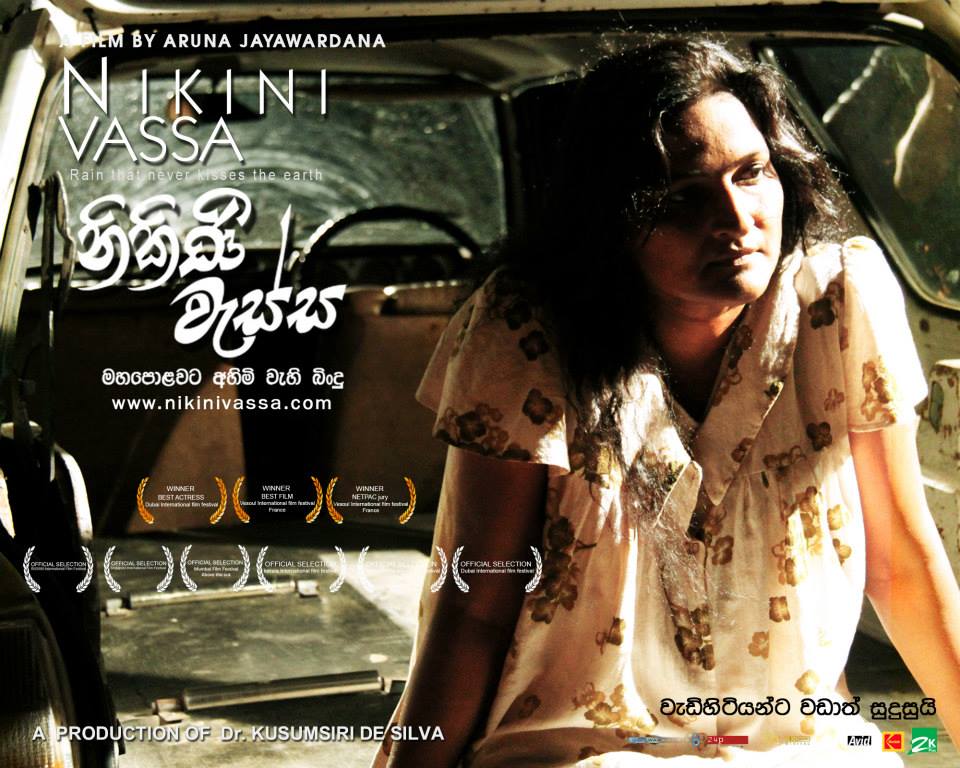NIKINI VASSA
Nikini Vassa is the story of an ambitious middle-aged
spinster who owns and operates a funeral parlor in a rural village. Her career goal
is to build a crematorium but this is threatened by a rival mortician who’ll
stop at nothing to prevent her from succeeding. Her personal goal is to find a
suitable partner to share her life with but this too is threatened because of
the stigma associated with her chosen profession.
This film’s story is undeniably unique; it’s unique not only to Sri Lankan cinema but to World Cinema as well. Sri Lankan films need more stories like this if the industry is to improve and move forward. Local films still have no discernible signature in the sphere of World Cinema, but Nikini Vassa is the change needed. The main character played by Chandani Seneviratne has to overcome two adversaries. The first is the ruthlessly competitive funeral director from the town, his goal is to monopolize the funeral business and eliminate his female competition. He is the ‘visible’ enemy. The second is the woman’s very profession; a middle-aged female mortician repels potential matrimonial suitors quite instantly. This is the ‘invisible’ enemy. The villagers too, display a general disdain towards her because of the miserable nature of her occupation. Add to this the wild elephant menace that rural villages have to go through and you’ve got the perfect storm of conflict. Inner and outer conflict is abundant which makes for absorbing drama. Yet the simplicity in the story is its best feature. Taking an extraordinary character and putting her in somewhat ordinary situations is more than enough to keep the audience engaged. All the characters are distinctive, each having an individual drive. The loyal funeral parlor assistant, the pensive architect, the disabled ex-soldier, the corrupt village officer and the callous town funeral director make up the colourful collection of characters.
Actors can make or break a film, which is why hiring the right actors is essential. Certain Sri Lankan actors who began their careers on stage have a habit of using the same style of acting on the silver screen. These actors appear stiff and unnatural. But the actors in Nikini Vassa are as natural as breathing. They have been perfectly cast for their respective roles. The five supporting male actors compliment the leading actress. Jagath Manuwarna, Bimal Jayakody, Thumindu Dodanthenna, Lakshman Mendis and Daya Alwis are all subtle yet exceptional in their performances. But the prominent performance is that of Chandani Seneviratne, with delicate mannerisms she adds layer upon layer to her character. She is remarkable in demonstrating the duality of her role. She displays undying hopefulness in love and career while going through despair in trying to accomplish these dreams. Seneviratne is a much sought after actress particularly for her range and her commitment to her roles. Calling her ‘The Sri Lankan Meryl Streep’ would certainly not be an overstatement.
Channa Deshapriya’s cinematography captures the baron landscape of the East vividly. The browns and earthy colour scheme enhances the dreariness of the village and is also a metaphor to the dull lives led by the villagers. Fundamental frame composition is used to tell the story instead of relying on the dialogue. The shots of the tractor hauling newly made coffins to the funeral parlor are an excellent example of visual storytelling. The number of coffins being transported increases with every shot which tells the audience that business is also increasing for the tiny village funeral house. Nadeeka Guruge’s unconventional score is a fine match to the subject matter. His use of minimal notes and at times guttural sounds give the film a primal feeling.
Aruna Jayawardana’s script and direction is a sort of public service announcement for producers and audiences; stressing the need to support new filmmakers. New producers like to put their money on old horses, and by old horses I mean film directors of yesteryear who recycle worn out stories in order to relive the glory days. This trend needs to stop. Instead film financiers should invest in new filmmakers with brand new not second-hand stories. Jayawardana has made a one of a kind film and he’s done it with simple techniques. He has used the mise en scene impeccably to bring his story to life.
The
‘mise en scene’ is basically defined as the frame composition. He has combined
an interesting plot, affective dialogue, great actors, quality cinematography
and uncommon music to make a memorable movie. Filmmaking is a sociable art form
in which many individuals contribute to a greater purpose but in this case
special credit must be given to the director for assembling such a winning
combination.
Rating: 9/10
S. V. Fernando



Comments
Post a Comment